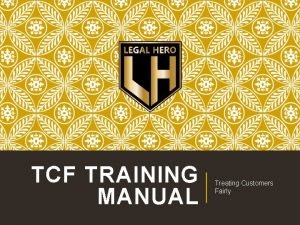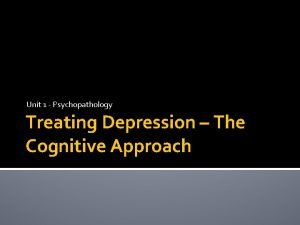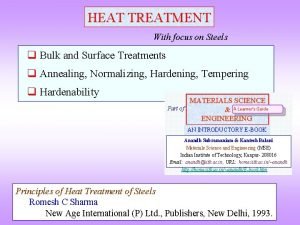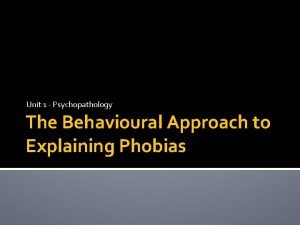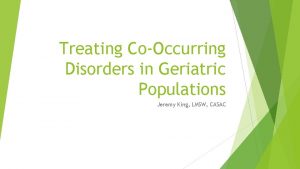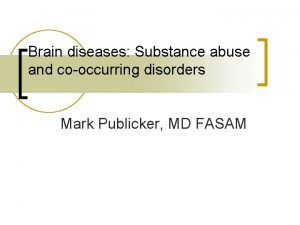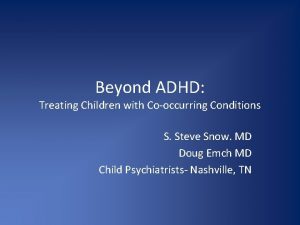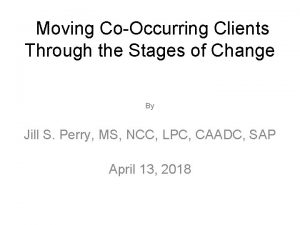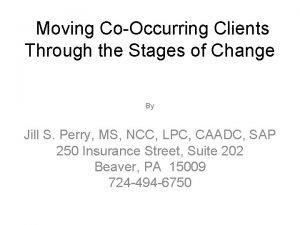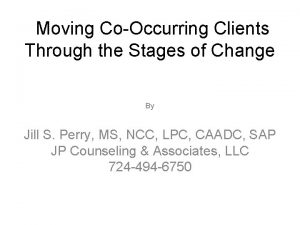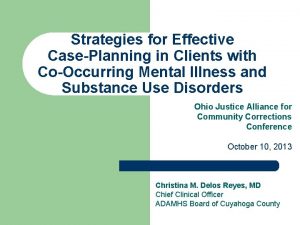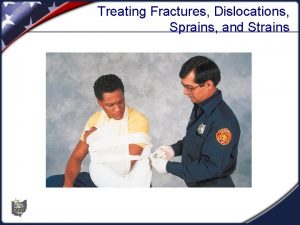TREATING CLIENTS WITH COOCCURRING DISORDERS Mark Haskins 1










- Slides: 10

TREATING CLIENTS WITH CO-OCCURRING DISORDERS Mark Haskins 1

Co-Occurring Disorders �Substance use disorder + other mental health disorder �DSM-IV TR � 112 Primary mental health disorders (Axis I) � 11 Personality disorders (Axis II) � 13 Primary substance use disorders �Heterogeneous �Each client is unique 2

Rates and Risks Frequency of co-occurrence and increased risk factor �Bi-polar Disorder 60% � 6. 6 times more likely than general population �Schizophrenia 47% � 4. 6 times … �Affective Disorders 32% � 1. 9 times … �Anxiety Disorder 36% � 1. 7 times … �Obsessive-Compulsive Disorder 33% � 2. 5 times … (Epidemiological Catchment Area Study, Regier et al. , 1990) 3

Drugs, Alcohol and SMI Question Do drugs and alcohol work to reduce psychiatric symptoms for individuals with significant mental illness (SMI) ? __Yes __No 4

Drugs, Alcohol and SMI Answer Yes, drugs and alcohol may provide transient (short term) symptom reduction …but, No, long-term effects of drug and alcohol use by individuals with significant mental illness include � symptom exacerbations � increased rate of hospitalization Alcohol Use Disorder and Severe Mental Illness, Drake and Mueser, 1996; Integrated Treatment of Dual Disorders, Mueser et al. , 2003; Acute Effect of Drug Abuse in Schizophrenic Patients: Clinical Observations and Patients’ Self Reports, Dixon et al. , 1990 5

Treatment Challenges � Treatment that is not integrated � Historical models: two separate treatment paths � � Mental Health (deinstitutionalization) Substance Abuse (self-help) � Substance Use Disorders in persons with severe mental illness often unrecognized by MH providers � Lack of standard screening and evaluation procedures � Clinician’s focus on MH or SA � Paucity of resources � Crisis management only 6

Treatment Recommendations �Integrated treatment �Longitudinal �Stage-wise �Start early �Cross-training �Improved screening and evaluation procedures �Increase clinician awareness �Assessment instruments �Teamwork 7

Treatment Methods �Dialectical Behavior Therapy (an example) � Stresses integrated team approach � Longitudinal treatment course � Evidence-based results �Need for prolonged engagement � No quick fixes � Therapeutic engagement based on genuine empathy (Cognitive Behavioral Treatment of Borderline Personality Disorder, M. Linehan, 1993; Dialectical Behavior Therapy in Clinical Practice: Applications across disorders and settings, Dimeff & Koerner, 2007) 8

Treatment Stigma �Effects of incarceration � No increased rates of mental health disorders while incarcerated � Increased risk of health & mental health disorders post release �Overburdened agencies and clinics � Limiting services by blaming clients � Is this a form of rationing? � What is the solution? Enduring Stigma: The Long-Term Effects of Incarceration on Health. Schnittker & John, (2007) 9

Summary �High prevalence of SUD for persons with significant mental illness. �Need to engage in genuinely empathetic and honest therapeutic relationships �Training and Treatment Methods �Integrated Treatment �Shared Community Responsibility 10
 Ortal lieberman
Ortal lieberman The day martin luther king jr was shot by jim haskins
The day martin luther king jr was shot by jim haskins Tcf outcomes 1 6
Tcf outcomes 1 6 Cognitive approach to treating depression
Cognitive approach to treating depression Wholesale heat treating
Wholesale heat treating Ethical issues in treating lgbt patients
Ethical issues in treating lgbt patients Chapter 4 ethics and social responsibility
Chapter 4 ethics and social responsibility Chapter 24 lesson 2 preventing and treating stds
Chapter 24 lesson 2 preventing and treating stds Two process model of phobias evaluation
Two process model of phobias evaluation Tumor treating fields mechanism of action
Tumor treating fields mechanism of action Typologie des clients insatisfaits
Typologie des clients insatisfaits


